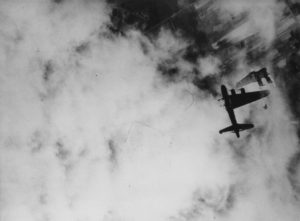 8 April 1945: Wee Willie, a Flying Fortress heavy bomber, left its base at Air Force Station 121 (RAF Bassingbourne, Cambridgeshire, England), on its 129th combat mission over western Europe. The aircraft commander was 1st Lieutenant Robert E. Fuller, U.S. Army Air Forces.
8 April 1945: Wee Willie, a Flying Fortress heavy bomber, left its base at Air Force Station 121 (RAF Bassingbourne, Cambridgeshire, England), on its 129th combat mission over western Europe. The aircraft commander was 1st Lieutenant Robert E. Fuller, U.S. Army Air Forces.
The 322nd Bombardment Squadron was part of an attack against the locomotive repair facilities at the railroad marshaling yards in Stendal, Saxony-Anhalt Germany. The squadron was bombing through clouds using H2S ground search radar to identify the target area. Antiaircraft gunfire (flak) was moderate, causing major damage to four B-17s and minor damage to thirteen others. Two bombers from the 91st Bomb Group were lost, including Wee Willie.
The Missing Air Crew Report, MACR 13881, included a statement from a witness:
“We were flying over the target at 20,500 feet [6,248 meters] altitude when I observed aircraft B-17G, 42-31333 to receive a direct flak hit approximately between the bomb bay and #2 engine. The aircraft immediately started into a vertical dive. The fuselage was on fire and when it had dropped approximately 5,000 feet [1,524 meters] the left wing fell off. It continued down and when the fuselage was about 3,000 feet [914.4 meters] from the ground it exploded and then exploded again when it hit the ground. I saw no crew member leave the aircraft or parachutes open.”
The pilot, Lieutenant Fuller, did escape from the doomed bomber. He was captured and spent the remainder of the war as a Prisoner of War. The other eight crew members, however, were killed.
Wee Willie was the oldest B-17G still in service with the 91st Bomb Group, and the next to last B-17 lost to enemy action by the group before the cessation of hostilities. The War in Europe came to an end with the unconditional surrender of Germany just 30 days later, 7 May 1945.
Source: © 2019, Bryan R. Swopes, https://www.thisdayinaviation.com/8-april-1945/
